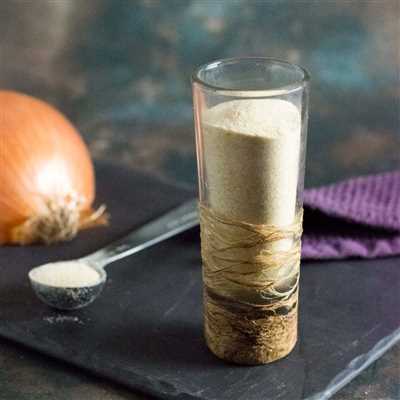
Onion powder is a versatile and flavorful seasoning that can be used in a variety of recipes. Making your own homemade onion powder from scratch is simple and allows you to control the quality of the ingredients. Instead of purchasing onion powder from stores, which often contain additives and preservatives, you can easily make your own using fresh onions.
To make onion powder, you will need onions, preferably bulbs that were dried for a few days. The drying process ensures that the onions are dehydrated and will grind into a fine powder. If the onions were not completely dried, the powder may clump together. The best onions for onion powder are those with a strong flavor and a pungent smell.
To start the process, you can choose between different operations for producing onion powder. One method is oven-drying the onion slices, which requires low and slow heat for several hours until they become brittle. Another option is using a dehydrator, which is a small-scale appliance that evenly dries the onions. If you have more onions to process, investing in a dehydrator might be a helpful choice.
Once the onions are dried and brittle, you can start grinding them into powder. Using a mortar and pestle can be a tedious task, especially if you have a large quantity of onions. Therefore, it is recommended to use a food processor or a spice grinder. Simply add the dried onion pieces to the processor or grinder and process until you achieve the desired powdered consistency.
After grinding the onions, it is important to store the onion powder properly to maintain its flavor and longevity. Transfer the freshly made onion powder into an airtight container, preferably a glass jar, and store it in a cool and dry area. Onion powder can be stored for up to two years if properly stored.
Homemade onion powder can be a great addition to your pantry, as it can be used to season a variety of dishes. It adds a burst of flavor to soups, stews, sauces, and even marinades. The homemade version gives you more control over the intensity and flavor of the seasoning, allowing you to customize it to your taste. Additionally, making onion powder at home is more cost-effective in the long run compared to buying it from stores. With a small investment in the necessary equipment, you can produce flavorful onion powder at a fraction of the cost.
Overall, making your own onion powder is a worthwhile endeavor. It provides you with a high-quality seasoning that can elevate the taste of your favorite dishes. Whether you choose to oven-dry or use a dehydrator, grinding the onions into a fine powder will result in a versatile and flavorful ingredient that can enhance your culinary creations. So why not give it a try and explore the possibilities of homemade onion powder?
- How to Make Onion Powder at Home
- HOW TO MAKE ONION POWDER
- Oven-Drying Versus Using a Dehydrator
- Producing Onion Powder for Sale and to Extend the Season
- Grinding Dried Onions
- Best Onion Powder Substitutes
- 1. Fresh Onions
- 2. Granulated Onion
- 3. Dehydrated Onion Flakes
- 4. Minced Onion
- 5. Onion Salt
- 6. Shallots
- 7. Garlic Powder
- 8. Amaranth Powder
- Garlic powder or granulated garlic
- Onion salt
- Video:
- I Made A Copycat Version Of My Favorite Fast Food Burger
How to Make Onion Powder at Home
Making your own onion powder at home can be a simple and flavorful way to extend the production life of this versatile vegetable. Unlike fruits and many other vegetables, onions can be quite difficult to store for long periods without spoiling. By dehydrating and grinding them into a powder, you can create a homemade seasoning that adds a good flavor and color to many recipes.
There are a few different methods for making onion powder at home. One option is to use a dehydrator, which is a helpful tool for drying vegetables and fruits. If you don’t have a dehydrator, oven-drying is another option. Simply slice the onions into thin slices and spread them out on a baking sheet. Bake them at a low temperature (around 150°F or 65°C) for several hours until they are completely dried out.
Once the onions are dried, you can grind them into a powder using a mortar and pestle, a spice grinder, or a small coffee grinder. If you prefer a more coarse texture, you can also crush the dried onions into flakes instead of powder. Just make sure to store the powder or flakes in an airtight container to avoid moisture absorption.
If you want to add some variety to your homemade onion powder, you can also experiment with adding other dried vegetables or herbs. For example, you could mix in some dried garlic or zucchini slices to achieve a more flavorful blend. It’s recommended to blanch these additional ingredients before drying them to help maintain their vibrant colors.
When using your homemade onion powder, keep in mind that it is much more potent than fresh onions. A general rule is to use about half a teaspoon of powdered onion for every small onion called for in a recipe. You can always test the flavor and adjust as needed. Remember that onion powder is also a great addition to spice blends and can be used to season various dishes.
If you’re looking to make a larger quantity of onion powder for sale or for personal use, investing in a specialized onion dehydrator or a commercial-grade spice mill may be worthwhile. These tools can help streamline the process and ensure consistent results with larger batches of onions.
To sum up, making onion powder at home can be a cost-effective and flavorful way to preserve excess onions or simply enjoy the convenience of having this versatile ingredient readily available. Whether you opt for a homemade dehydrator or use the oven-drying method, the result will be a fragrant and flavorful powder that can enhance a wide range of recipes.
HOW TO MAKE ONION POWDER
Onion powder is a versatile and flavorful ingredient that can add depth to various dishes. Making your own homemade onion powder is a simple and cost-effective way to enhance the taste of your favorite recipes. In this article, we will guide you through the steps of making onion powder at home.
Step 1: Gather the onions
Start by selecting good-quality onions. You can use either white or yellow onions for this process. Onions that are firm and free from any soft spots or mold are ideal. Aim for onions that are medium-sized as they are easier to work with.
Step 2: Prepare the onions
Wash the onions thoroughly and remove the outer skin. Slice the onions into thin, even slices. You can use a sharp knife or a mandoline slicer for this task. It is important to ensure that all the slices are uniform in thickness as this will help them dry evenly.
Step 3: Dry the onions
There are a few different methods you can use to dry the onion slices:
– Oven-drying: Arrange the onion slices in a single layer on a baking sheet. Place the sheet in an oven preheated to a low temperature, around 170°F (77°C). Leave the oven door slightly open to allow moisture to escape. It can take anywhere from 4 to 8 hours for the onion slices to fully dry.
– Using a food dehydrator: Follow the manufacturer’s instructions for your specific dehydrator. Spread the onion slices evenly on the dehydrator trays and set the temperature to around 130°F (54°C). Drying times can vary, but it typically takes about 6 to 8 hours.
– Air-drying: If you live in a warm and dry climate, you can try air-drying the onion slices. Place them on a wire rack in a well-ventilated area. This method can take several days to a week, depending on the weather conditions.
Step 4: Grind into powder
Once the onion slices are completely dry and brittle, they are ready to be ground into powder. You can use a blender, food processor, coffee grinder, or spice grinder for this step. Simply add the dried onion slices to the grinder and pulse until you achieve a fine powder-like consistency. Make sure to scrape the sides and bottom of the grinder to ensure everything is evenly processed.
Step 5: Store the onion powder
Transfer the freshly ground onion powder to an airtight container. A small glass jar with a tight-fitting lid works well. Store the container in a cool, dry place away from direct sunlight. Homemade onion powder can last for up to a year if stored properly.
Tips:
– If you prefer a more intense flavor, you can roast the onion slices in a warm oven for a few minutes before drying. This will help enhance the overall taste of the powder.
– To extend the shelf life of your onion powder, you can add a pinch of salt or a small amount of ascorbic acid to the powder. This will help preserve its freshness for a longer period of time.
– If you are unable to find fresh onions or prefer a simpler method, you can purchase dehydrated onion slices or flakes from local stores or online. These can be easily ground into powder using the same technique.
Substitutes:
If you don’t have onion powder on hand and need a quick substitute, you can use minced fresh onions or granulated garlic. Though the flavor may not be exactly the same, they can add a similar depth to your dishes.
In conclusion, making onion powder at home is a simple and rewarding process. With a small investment in time and effort, you can enjoy flavorful, homemade onion powder that can elevate your culinary creations. Give it a try and experience the difference!
Oven-Drying Versus Using a Dehydrator
When it comes to making onion powder, there are two primary methods you can choose from for drying your onions: oven-drying and using a dehydrator. Both options have their advantages and it ultimately depends on your preferences and available resources.
If you’re looking for a simple and inexpensive way to make onion powder, oven-drying is a great choice. All you need are some fresh onions and an oven. Simply peel and slice the onions into thin pieces, around 1/8 inch thick. Then, spread the slices out in a single layer on a baking sheet and place them in a preheated oven at a low temperature, around 150-200°F (65-93°C). Leave the oven door slightly ajar to allow moisture to escape. You can use a wooden spoon or oven mitt to prop it open. Let the onions dry for several hours, or until they have a brittle texture. Once they are dried, remove them from the oven and let them cool completely.
Using a dehydrator is another option, especially if you plan on making onion powder regularly or if you have a large crop of onions to process. Dehydrators are specifically designed to remove moisture from foods and they provide consistent and controlled heat and airflow. To use a dehydrator, simply slice your onions into even pieces and arrange them on the dehydrator trays. Follow the manufacturer’s instructions for the recommended temperature and drying time. It’s important to note that dehydrators typically operate at a higher temperature than oven-drying, which can help to avoid over-drying and preserve the color and flavor of the onions.
Regardless of whether you choose to use an oven or a dehydrator, it’s important to ensure that your dried onions are completely moisture-free before grinding them into powder. Any residual moisture can lead to clumping or spoilage during storage. You can test the onions by breaking a slice in half and checking for any signs of moisture or flexibility.
To make onion powder, simply place the dried onion slices in a blender, food processor, or mortar and pestle. Process the slices until they reach the desired consistency, from flakes to a fine powder. If you prefer a smoother texture, you can also sift the powder to separate any larger pieces. Once your onion powder is ready, store it in an airtight container to keep it fresh and flavorful. An important tip is to add a teaspoon of salt or ascorbic acid to the powder to help preserve its color and flavor.
In addition to the convenience of making your own homemade onion powder, there are also other benefits. By making your own powder, you have control over the quality of the onions used, and you can avoid additives or preservatives that are often found in store-bought substitutes. Homemade onion powder also adds a unique and more intense flavor to your recipes, perfect for seasoning dishes like garlic bread, zucchini chips, or amaranth salad.
Whether you choose oven-drying or using a dehydrator, both methods offer a simple and efficient way to make onion powder. Consider your preferences, available resources, and the amount of onion powder you plan on producing when making your decision. Whichever method you choose, enjoy the process of transforming fresh onions into a versatile and flavorful seasoning that can elevate your culinary creations.
Producing Onion Powder for Sale and to Extend the Season
Producing onion powder can be a profitable business and an effective way to extend the availability of onions even during the off-season. To make onion powder, the first step is to select the best onions for processing. Onions that are firm, dry, and have a strong flavor would be the ideal choice.
These selected onions can be separated into bulbs, and then finely minced or processed in a food processor. Alternatively, they can be sliced and dried. If you prefer, you can blanch the onions in boiling water for a short period of time to reduce their pungency and make them more mild in flavor.
After the onions have been prepared, there are several methods for drying them. One simple method is to use a homemade dryer, such as a frame with a cloth over it, placed in a well-ventilated room. The onions can be spread out on the cloth and left to dry naturally over a period of several weeks. Another option is to use an oven-drying method, which involves spreading the onions in a single layer on a baking sheet and placing them in a low-heat oven for several hours.
Once the onions are completely dried, they can be ground into a powder. This can be done usin`g a mortar and pestle, or with the help of a food processor or spice grinder. The resulting powder should have a fine texture and a rich, deep color.
To achieve the desired flavor and color of the onion powder, some producers may add a small amount of ascorbic acid or other seasoning. This is often done to mimic the flavor of freshly diced or minced onions. However, it is important to note that the addition of seasonings or flavorings may affect the natural taste and nutritional content of the powder.
Once the onion powder is ready, it can be packaged and sold in stores or used as a key ingredient in various recipes. Many people prefer homemade onion powder over the store-bought alternatives, as it is often considered to be more flavorful and fresher. Additionally, producing onion powder domestically reduces the reliance on imported or overseas sources.
Producing onion powder for sale can be a challenging process, especially for small-scale operations. However, with the right methods and techniques, it can be a profitable venture. By carefully selecting and processing the onions, using recommended drying methods, and maintaining proper storage conditions, producers can ensure the production of high-quality onion powder that can be enjoyed throughout the year.
Overall, producing onion powder is a valuable way to extend the availability of this popular seasoning and provide consumers with a convenient and flavorful alternative to fresh onions. Whether for commercial sale or personal use, making onion powder is a rewarding process that allows individuals to enjoy the benefits of onions, regardless of the weather or growing season.
Grinding Dried Onions

Once your onions are completely dried, it’s time to grind them into a fine powder. There are a few different methods you can use depending on the tools you have available:
Mortar and Pestle: If you have a mortar and pestle, this is a traditional and effective way to grind dried onions. Simply add a small amount of the dried onion flakes or slices to the mortar, and use the pestle to crush and grind them into a powder. This method requires some elbow grease, but it can be quite satisfying to make your own onion powder from scratch.
Food Processor or Blender: If you have a food processor or blender, you can use this appliance to grind dried onions. Simply add the dried onion flakes or slices to the processor or blender, and pulse until you achieve the desired consistency. You may need to do this in batches if you have a large quantity of dried onions.
Coffee or Spice Grinder: If you have a coffee or spice grinder, this is another tool that can be used to grind dried onions. Simply add small batches of the dried onion flakes or slices to the grinder, and pulse until you have a fine powder. Be sure to clean the grinder thoroughly before and after using it for spices, as the onion aroma can linger.
Regardless of which method you choose, it’s important to store your onion powder in an airtight container to maintain its freshness and flavor. You can use glass jars with tight-fitting lids or other airtight containers that can be sealed properly. Be sure to label the container with the date the powder was made.
Onion powder can be a flavorful addition to many recipes, adding a savory and slightly sweet onion taste. It can be used as a seasoning for meats, soups, sauces, and marinades. It can also be sprinkled over vegetables like zucchini or added to homemade salad dressings. If you’re looking for a salt substitute, you can even mix onion powder with other herbs and spices to create your own blend.
While store-bought onion powder is readily available, making your own allows you to control the quality and flavor of the final product. Homemade onion powder can be more vibrant in color and have a stronger flavor compared to processed versions. It’s a small investment of time and effort that can yield great results.
Best Onion Powder Substitutes
When it comes to cooking, onion powder is a versatile ingredient that adds flavor and depth to many recipes. However, if you run out of onion powder or prefer not to use it, there are several alternatives you can try. Here are some of the best substitutes for onion powder:
1. Fresh Onions
If you have onions on hand, using fresh onions is the closest substitute for onion powder. Simply mince or finely chop the desired amount of onions and use them in your recipe.
2. Granulated Onion
Granulated onion is another good alternative to onion powder. It is made by dehydrating onions and grinding them into smaller pieces. Granulated onion has a similar flavor and texture to onion powder, but the pieces are slightly larger.
3. Dehydrated Onion Flakes
Dehydrated onion flakes are larger pieces of dehydrated onion that can be used as a substitute for onion powder. They have a similar flavor but a different texture compared to onion powder.
4. Minced Onion
Minced onion is made by finely chopping dried onions and can be used as a substitute for onion powder. It adds a slightly different texture but still provides a good onion flavor.
5. Onion Salt

If you have onion salt on hand, you can use it as a substitute for onion powder. Keep in mind that onion salt contains salt, so you may need to adjust the amount of salt used in your recipe.
6. Shallots
Shallots are an excellent alternative to onion powder, especially if you’re looking for a milder flavor. Finely chop or mince the desired amount of shallots and use them in place of onion powder.
7. Garlic Powder
If you don’t have onion powder but have garlic powder instead, you can use it as a substitute. Although it won’t provide the exact same flavor, garlic powder adds a savory kick to your dishes.
8. Amaranth Powder
Amaranth powder is a lesser-known alternative to onion powder. It is made from the amaranth plant, which has a slightly nutty and sweet taste. Use it sparingly as a seasoning in recipes.
Remember to adjust the amount of substitute you use based on the recipe’s requirements and your personal taste preferences. These alternatives can help you achieve a similar flavor profile to onion powder when making or seasoning your favorite dishes!
Garlic powder or granulated garlic
In addition to onion powder, another popular pantry staple is garlic powder or granulated garlic. While it can be easily found in stores, making your own homemade version is a good option to consider.
Garlic powder is made by grinding dried garlic cloves into a fine powder, while granulated garlic consists of coarser granules. Both forms can be used interchangeably in recipes, but there are some differences to consider.
When it comes to making garlic powder or granulated garlic at home, there are a few methods you can try. One option is using a food processor or blender, which could be helpful if you have a large amount of garlic to process. Another method involves using a dehydrator or oven-drying to remove the moisture from the garlic cloves.
If you want to achieve the best results, it is recommended to blanch the garlic cloves before dehydrating them. This step helps to preserve the flavor and color of the garlic. Blanching involves boiling the cloves for a short period of time, usually just a minute or two, and then quickly removing them and transferring them to an ice bath to stop the cooking process.
Once the garlic cloves are blanched, you can then slice them into thin slices or mince them into smaller pieces. For dehydrating, you can use a dehydrator or spread the slices on a baking sheet and dry them in the oven at a low temperature for several hours. The drying time will depend on the size and thickness of the garlic slices as well as the weather conditions.
After the garlic slices are fully dried and crispy, you can grind them using a spice grinder, blender, or mortar and pestle. If you prefer a coarser texture, you can crush them into granules instead of powder. Make sure to store the garlic powder or granulated garlic in an airtight container to maintain its flavor and shelf life.
Growing your own garlic or purchasing fresh garlic from local farmers or markets is a great way to ensure the quality and freshness of the garlic used in making garlic powder or granulated garlic. Homemade garlic powder or granulated garlic can be a cost-effective and flavorful alternative to store-bought options.
In addition to using garlic powder or granulated garlic as a spice or seasoning, it can also serve as a substitute for fresh garlic in recipes. It provides a concentrated flavor that can be added to soups, stews, marinades, sauces, and other dishes. Just remember that the intensity of the flavor can vary, so it is recommended to start with a small amount and adjust to taste.
Overall, making your own garlic powder or granulated garlic allows you to have control over the quality, flavor, and additives used. It can be a fun and rewarding culinary project, especially for those who enjoy experimenting with flavors in the kitchen.
Whether you choose to make your own garlic powder or purchase it, having this versatile ingredient on hand can enhance the flavor of many dishes and add depth to your cooking. So why not give it a try and enjoy the homemade goodness of garlic powder or granulated garlic in your favorite recipes?
Onion salt
If you’re looking to add a little extra flavor to your dishes, homemade onion salt is a simple and delicious seasoning option. Onion salt is a mixture of onion powder and salt, giving you the versatility of both flavors in one convenient blend. Making your own onion salt at home is surprisingly easy and can be a fun project to tackle.
The first step in making onion salt is to create onion powder. As discussed in the previous section, you can make onion powder by dehydrating onions and then grinding them into a fine powder. Once you have your homemade onion powder ready, you can proceed with making onion salt.
To make onion salt, you’ll need 1 tablespoon of onion powder and 2 tablespoons of salt. This ratio can be adjusted according to your taste preferences. Mix the onion powder and salt together in a small bowl until well combined. Store the onion salt in an airtight container to keep it fresh and readily available for use in your recipes.
Onion salt can be used in a variety of dishes, from soups and stews to marinades and rubs. It adds a savory umami flavor to any recipe and can enhance the taste of vegetables, meats, and more. When using onion salt, keep in mind that it contains salt, so you may need to adjust the amount of salt you add to your dish.
If you prefer a coarser texture, you can also make onion salt with onion flakes instead of onion powder. Simply replace the onion powder with onion flakes in the recipe and mix it with the salt as usual.
Commercially produced onion salt often contains additives and preservatives. By making your own onion salt at home, you can avoid these unwanted ingredients and have control over the quality of the final product. Plus, it can be a cost-effective option, especially if you have an abundant supply of onions from your garden or are able to purchase them at a lower cost.
So, if you’re looking to add a burst of flavor to your dishes, why not try making your own onion salt? It’s a simple, homemade seasoning option that can take your recipes to the next level.









